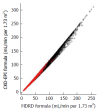Establishing the presence or absence of chronic kidney disease: Uses and limitations of formulas estimating the glomerular filtration rate
- PMID: 29026688
- PMCID: PMC5618145
- DOI: 10.5662/wjm.v7.i3.73
Establishing the presence or absence of chronic kidney disease: Uses and limitations of formulas estimating the glomerular filtration rate
Abstract
The development of formulas estimating glomerular filtration rate (eGFR) from serum creatinine and cystatin C and accounting for certain variables affecting the production rate of these biomarkers, including ethnicity, gender and age, has led to the current scheme of diagnosing and staging chronic kidney disease (CKD), which is based on eGFR values and albuminuria. This scheme has been applied extensively in various populations and has led to the current estimates of prevalence of CKD. In addition, this scheme is applied in clinical studies evaluating the risks of CKD and the efficacy of various interventions directed towards improving its course. Disagreements between creatinine-based and cystatin-based eGFR values and between eGFR values and measured GFR have been reported in various cohorts. These disagreements are the consequence of variations in the rate of production and in factors, other than GFR, affecting the rate of removal of creatinine and cystatin C. The disagreements create limitations for all eGFR formulas developed so far. The main limitations are low sensitivity in detecting early CKD in several subjects, e.g., those with hyperfiltration, and poor prediction of the course of CKD. Research efforts in CKD are currently directed towards identification of biomarkers that are better indices of GFR than the current biomarkers and, particularly, biomarkers of early renal tissue injury.
Keywords: Biomarkers of chronic kidney disease; Chronic kidney disease; Creatinine clearance; Creatinine excretion; Cystatin C; Estimated glomerular filtration rate; Hyperfiltration; Renal imaging; Serum creatinine.
Conflict of interest statement
Conflict-of-interest statement: Dominic S C Raj is supported by RO1 DK073665-01A1, 1U01DK099914-01 and IU01DK09924-01 from the National Institutes of Health. Joseph I Shapiro is supported by HL105649, HL071556 and HL109015 from the National Institutes of Health. The rest of the authors declare no conflicts of interest. This report was not supported by a grant.
Figures




Similar articles
-
Reliability of glomerular filtration rate estimating formulas compared to iohexol plasma clearance in critically ill children.Eur J Pediatr. 2022 Nov;181(11):3851-3866. doi: 10.1007/s00431-022-04570-0. Epub 2022 Sep 2. Eur J Pediatr. 2022. PMID: 36053381 Clinical Trial.
-
Simple cystatin C formula compared to sophisticated CKD-EPI formulas for estimation of glomerular filtration rate in the elderly.Ther Apher Dial. 2011 Jun;15(3):261-8. doi: 10.1111/j.1744-9987.2011.00948.x. Ther Apher Dial. 2011. PMID: 21624073
-
Performance of the 2021 Race-Free CKD-EPI Creatinine- and Cystatin C-Based Estimated GFR Equations Among Kidney Transplant Recipients.Am J Kidney Dis. 2022 Oct;80(4):462-472.e1. doi: 10.1053/j.ajkd.2022.03.014. Epub 2022 May 16. Am J Kidney Dis. 2022. PMID: 35588905
-
GFR estimation: from physiology to public health.Am J Kidney Dis. 2014 May;63(5):820-34. doi: 10.1053/j.ajkd.2013.12.006. Epub 2014 Jan 28. Am J Kidney Dis. 2014. PMID: 24485147 Free PMC article. Review.
-
A Unifying Approach for GFR Estimation: Recommendations of the NKF-ASN Task Force on Reassessing the Inclusion of Race in Diagnosing Kidney Disease.Am J Kidney Dis. 2022 Feb;79(2):268-288.e1. doi: 10.1053/j.ajkd.2021.08.003. Epub 2021 Sep 23. Am J Kidney Dis. 2022. PMID: 34563581 Review.
Cited by
-
Consistency of metabolite associations with measured glomerular filtration rate in children and adults.Clin Kidney J. 2024 Apr 24;17(6):sfae108. doi: 10.1093/ckj/sfae108. eCollection 2024 Jun. Clin Kidney J. 2024. PMID: 38859934 Free PMC article.
-
Liquid Chromatography-Mass Spectrometry Analytical Methods for the Quantitation of p-Cresol Sulfate and Indoxyl Sulfate in Human Matrices: Biological Applications and Diagnostic Potentials.Pharmaceutics. 2024 May 30;16(6):743. doi: 10.3390/pharmaceutics16060743. Pharmaceutics. 2024. PMID: 38931865 Free PMC article. Review.
-
Urinary cyclophilin A as an early marker of chronic kidney disease with underlying type 2 diabetes.Sci Rep. 2024 Oct 5;14(1):23207. doi: 10.1038/s41598-024-73994-5. Sci Rep. 2024. PMID: 39369057 Free PMC article.
-
Estimated Glomerular Filtration Rate in Chronic Kidney Disease: A Critical Review of Estimate-Based Predictions of Individual Outcomes in Kidney Disease.Toxins (Basel). 2022 Feb 8;14(2):127. doi: 10.3390/toxins14020127. Toxins (Basel). 2022. PMID: 35202154 Free PMC article. Review.
-
Comparative Determination of Glomerular Filtration Rate Estimation Formulae in Type 2 Diabetic Patients: An Observational Study.Biomed Res Int. 2024 Jun 10;2024:9532236. doi: 10.1155/2024/9532236. eCollection 2024. Biomed Res Int. 2024. PMID: 38903148 Free PMC article.
References
-
- Said A, Desai C, Lerma EV. Chronic kidney disease. Dis Mon. 2015;61:374–377. - PubMed
-
- Coresh J, Selvin E, Stevens LA, Manzi J, Kusek JW, Eggers P, Van Lente F, Levey AS. Prevalence of chronic kidney disease in the United States. JAMA. 2007;298:2038–2047. - PubMed
-
- Pereira ER, Pereira Ade C, Andrade GB, Naghettini AV, Pinto FK, Batista SR, Marques SM. Prevalence of chronic renal disease in adults attended by the family health strategy. J Bras Nefrol. 2016;38:22–30. - PubMed
-
- Moţa E, Popa SG, Moţa M, Mitrea A, Penescu M, Tuţă L, Serafinceanu C, Hâncu N, Gârneaţă L, Verzan C, et al. Prevalence of chronic kidney disease and its association with cardio-metabolic risk factors in the adult Romanian population: the PREDATORR study. Int Urol Nephrol. 2015;47:1831–1838. - PubMed
-
- Zdrojewski Ł, Zdrojewski T, Rutkowski M, Bandosz P, Król E, Wyrzykowski B, Rutkowski B. Prevalence of chronic kidney disease in a representative sample of the Polish population: results of the NATPOL 2011 survey. Nephrol Dial Transplant. 2016;31:433–439. - PubMed
Publication types
Grants and funding
LinkOut - more resources
Full Text Sources
Other Literature Sources
Research Materials
Miscellaneous

